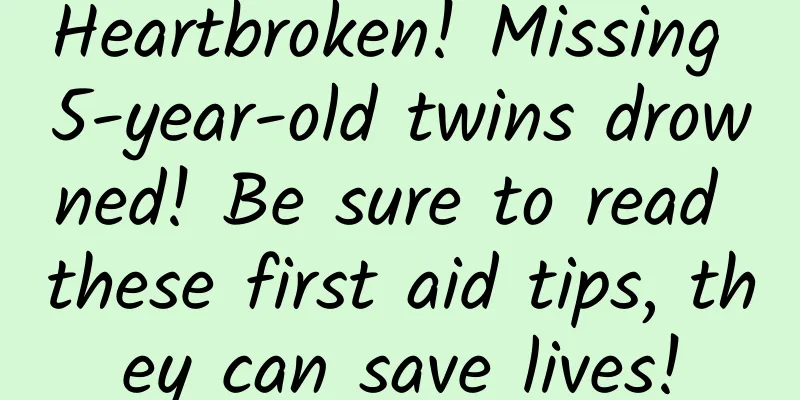Heartbroken! Missing 5-year-old twins drowned! Be sure to read these first aid tips, they can save lives!

|
On May 15, the People's Government of Zhushan Town, Yu Shui District, Xinyu City, Jiangxi Province issued a "Notice on the Search Situation of Lost Children in Huatian Village, Zhushan Town." The report stated that at 18:45 on May 13, the Zhushan Police Station of the Yushui Branch of the Xinyu Municipal Public Security Bureau received a call from 110 reporting that two five-year-old twin children (Liao Mouxu and Liao Mouyang) were lost in Huatian Village, Zhushan Town at around 15:30 that day, and requested assistance in finding them. After receiving the alarm, the city and district levels attached great importance to it, and the public security, government emergency departments and volunteers made every effort to search and find. After continuous work day and night, at 5:55 on May 15, the search and rescue personnel found the body of a boy in the Shangcun section of Yuanhuiqu and salvaged it ashore; at 9:17, the body of another child was found in the Yangjin section of Yuanhuiqu and salvaged ashore. After verification, it was confirmed that the deceased were two missing children (Liao Mouxu and Liao Mouyang), and it was initially determined that they fell into the water and died. The tragedy of the two children is heartbreaking, and it also serves as a wake-up call for us: As the weather gets warmer, child drowning incidents will enter a high incidence season. How to avoid tragedies? What to do if a child drowns? Here are some "drowning prevention" knowledge, I hope you will never need it, but it is very necessary to master it! 01 What happens to the human body when drowning? The drowning person initially shows symptoms of panic, breath holding, and desperate struggling, and eventually inhales forcefully reflexively. When water enters the lower respiratory tract, the larynx reflexively spasms, closing the breathing passage ("dry drowning"), leading to hypoxemia , which in turn affects various organ systems throughout the body, the most affected of which are the lungs (atelectasis, pulmonary edema), brain (cerebral edema, increased intracranial pressure), heart (arrhythmias, cardiac arrest), and kidneys (acute kidney injury). 02 Why is it wrong to control water after drowning? The reason why drowning victims do not change their consciousness or die due to inhaling or swallowing too much water is because of hypoxemia, which is a variety of complications caused by lack of oxygen. Therefore, it is inappropriate to "control water" by standing upside down, hanging upside down, pressing the abdomen (Hay's method) and other measures for drowning victims , which will delay the correct rescue time. How to make children with lack of oxygen get enough oxygen is the key to our rescue! Copyright image, no permission to reprint 03 Correct rescue measures after drowning The first thing to do is to get the drowning person out of the water as quickly as possible . When a rescuer realizes that someone may be drowning (the body is nearly vertical, the arms are constantly paddling downwards or the legs are kicking and pushing, but they are not swimming forward), they should take any available measures (tools) to remove the drowning person from the water while ensuring their own safety: ① Hand over sticks, oars, life-saving items (throw ropes or floating objects) from the shore or boat; ② Use tools to drag the drowning person to the shore or boat; ③ Carry life-saving items and row a small boat to reach the drowning person; ④ Jump into the water to rescue (very dangerous for the rescuer, only as a last resort). After the drowning person is rescued from the water, cardiopulmonary resuscitation should be performed on the spot as soon as possible . The success of on-site cardiopulmonary resuscitation and the consciousness of the drowning person are the main factors in determining whether the drowning person can survive. Once the drowning child is rescued from the water, cardiopulmonary resuscitation should be started immediately. Step 1: Quickly place the drowning person in a supine position, pat and call the drowning person. Step 2: If there is no response, open the airway (press the forehead and lift the jaw) and observe whether there is any foreign object in the mouth and nose of the drowning person. If there is any foreign object in the mouth and nose, quickly clear the sand, debris or vomit in the mouth and nose to make the airway unobstructed; perform artificial respiration 5 times. Step 3: Check the carotid artery pulse (stretch out the index finger and middle finger, put them together, place them under the Adam's apple, and slide them to the side 2 to 3 cm). (1) The drowning person has no pulse: Perform cardiopulmonary resuscitation immediately. Compression-ventilation ratio: 30:2 for single rescue, 15:2 for two rescuers, and compression frequency of 100 to 120 times/minute. The compression sites are as shown in the figure according to age. Infants use the two-hand embrace method (Figure 1), and children over 8 years old and adults use the two-hand stacking method (Figure 2). Figure 1: The baby is held in the arms. Copyrighted images are not authorized for reproduction Figure 2: Children over 8 years old and adults use the double-handed method. Copyright images are not authorized for reproduction (2) The drowning person has a pulse: Start artificial respiration. Usually, spontaneous breathing can be restored after a few artificial respirations. Actively seek help during the rescue process and send the child to a nearby hospital in time. For hypothermic drowning victims, many advanced cardiovascular life support (ACLS) interventions are ineffective (such as pacemakers, atropine, lidocaine, and defibrillators). During cardiopulmonary resuscitation of drowning victims, it is important to use available conditions to keep them warm . When rescuing yourself in the water, you can hug your knees or hug others to reduce the loss of body heat, thereby slowing down the drop in body temperature. If you accidentally fall into the water from the ice, the self-rescue methods are as follows: Use your arms to firmly support your upper body on the ice. Raise your legs to the level of the ice, then use the strength of your arms to pull your body forward. Slide and roll to get off the ice (do not stand). 04 How to prevent children from drowning? Having sufficient safety awareness and rescue skills is the key to preventing drowning: 1. Make sure your child is always within your sight, especially young children who can crawl and walk but do not understand what danger is. 2. Try to minimize the use of bathtubs, buckets and other items that may pose safety hazards in your home. 3. Provide children with safety education on drowning prevention. There must be lifeguards and related first aid equipment in swimming pools and outdoor swimming. Do not swim in the wild. 4. Children and parents should learn basic skills for escaping from water. Children’s safety is no small matter, be prepared to ensure safety! Author: Duan Li, Zhuhai Maternal and Child Health Hospital; Jiang Chunming, Chief Physician, Zhuhai Maternal and Child Health Hospital Reviewer: Zheng Chengzhong, Chief Physician of the Strategic Support Force Special Medical Center Submitted by: Chinese Medical Association The cover image and the images in this article are from the copyright library Reproduction of image content is not authorized |
<<: Why do mother penguins "abandon" the first egg they lay?
Recommend
It is said online that "the Forbidden City has lasted for 600 years and has never been flooded." Did the ancients really have advanced drainage technology?
Over the years, there has been a saying circulati...
Wang Xuan: The tactical life of the "contemporary Bi Sheng"
Wang Xuan is a famous computer scientist in my co...
A quick overview of scientific and technological achievements on the horizontal screen | Mengtian Laboratory Module and China Space Station
China's space station construction It is the ...
5 steps to write a hit article with 100,000+ views (Part 1)
What is your purpose in writing? No matter what yo...
There are penguins in Antarctica, what is there in the Arctic?
Produced by: Science Popularization China Author:...
100,000+? It is better to take these three steps to directly improve the conversion rate of copywriting!
"100,000+" is a high ground that countl...
Why is the coconut juice we have been drinking since childhood completely different from coconut water?
When you mention coconut, you may think of all ki...
The battle for attention is escalating: the 100,000+ era is over, the 1 million+ era is here
With the improvement of mobile Internet infrastru...
How much does it cost to invest in the Yili Kazakh Express mini program?
How much does it cost to invest in the Ili Kazakh...
Hongmeng OS internal test system experience exposed: the interface is obviously different from EMUI, simple and smooth
Last week, there was news that Hongmeng OS is bei...
The elderly in the family are suffering from "yang phobia". How should children guide them to resolve the problem?
Recently, with the optimization and adjustment of...
Celebrities were fined for endorsing weight loss products. Don’t buy weight loss products with this kind of ingredients!
Recently, the news #Jing Tian was punished for il...
All the reliable information about the new iPhone SE you care about is here
There is increasing evidence that a new 4.7-inch ...
In the face of artificial intelligence, what advantages do humans have that will make them irreplaceable?
Audit expert: Xu Runsheng PhD in Artificial Intel...
Where does the wind from a bladeless fan come from?
Nowadays, some parts of the country are still hot...









